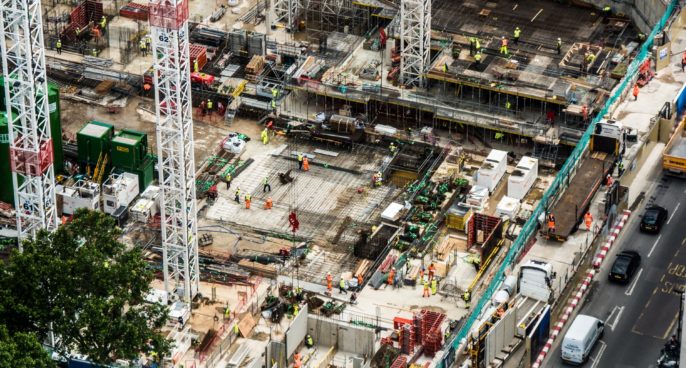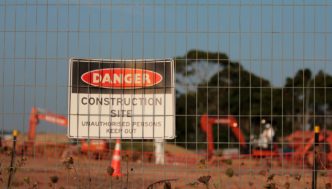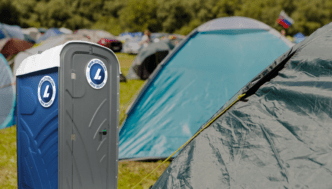
From residential homes to commercial construction projects, on building sites temporary toilets are a must. While some building sites enjoy access to permanent toilet facilities, most rely on temporary or mains-connected sanitation solutions. These mobile bathrooms are private, practical and easy to install on almost any building site.
Placement is everything, so it’s important to plan carefully when deciding where to install temporary toilets on building sites. To help you settle on the perfect location, we’ve put together a practical guide covering need-to-know information about building site toilets and the best places to install them.
Table of Contents
Safety first
Safety should always be front of mind when deciding where to place temporary toilets on building sites. Ideally, you should steer clear of locations that are within 10 to 15 feet of walkways, driveways or main roads. This is because from the inside, users aren’t able to see oncoming pedestrians or vehicles and as a result, may open the door and step out into oncoming traffic. Placing toilets away from high-traffic areas minimises the risks of accidents and helps maintain a safe workplace.
If your building site is located on the side of a road or highway, it’s best to add an extra layer of protection and place your portable toilets behind concrete barriers.
Look for stable and flat surfaces
While portable sanitation stations are extremely sturdy, it’s always best to install them on a surface that’s stable and flat. For example, a paved surface is much better than a soft, sandy spot that could result in the toilet unit shifting or slanting over time. Ideally, your chosen location should feature good drainage to eliminate the risk of flooding. A site with good drainage will also prevent mud from building up around the base of the toilet.
Access to mains connections
Clean, cost-effective and an absolute pleasure to use, mains-connected portable toilets are a great solution for long-term construction projects. The Health and Safety Executive states that flushing toilets connected to mains water and drainage systems should be installed where possible. By tapping into mains connections, you can treat your workers to full flushing facilities and sinks with running water.
While most temporary portable toilets require emptying on a weekly basis, mains-connected sanitation stations flush waste away and are ideal for heavy use. They operate in exactly the same way as a regular home or office toilet, with the mains water connection minimising maintenance and reducing odour. This makes them a great option not only for your budget, but also in terms of hygiene and comfort. Cleaning is a breeze and can be easily outsourced to a third party company, with antibacterial products and a good dose of elbow grease all that’s needed to stay on top of hygiene standards.
What if mains access isn’t available?
No access to mains water and sewage connections at your construction site? Don’t sweat it. Hiring a portable toilet with water tank attached is an easy solution. By plumbing your portable toilet into an attached water tank, you can offer your site workers luxuries like flushing and handwashing facilities, without the need for access to the main waterboard. With the capacity to store up to 1000 litres of water, these cavernous tanks can provide free flowing water to your site toilets, regardless of geographical or logistical issues that prevent you from tapping into the mains supply.
Rehydrating with a freshwater supply
While we’re on the topic of access to water, it’s worth mentioning services like fresh water replenish tanks. Dehydration is a major issue on construction and building sites, meaning it’s vital to provide your team with easy access to fresh drinking water. Secure water tanks are a simple way to keep your team hydrated and ensure your site complies with all HSE and UK water regulations. All tanks feature lock and tag security, meaning they remain 100% safe even when left unattended.
Easy access for cleaners and service vehicles
Your employees won’t be the only ones accessing your portable toilets, with cleaners and installation professionals also requiring good access. Choosing a location that can be easily reached by service vehicles is essential. This includes heavy-duty sanitation trucks sent to empty the toilets. These types of vehicles can’t usually venture off road or into muddy or sandy terrain, so it’s important to choose a location that isn’t too difficult to access. The last thing you want is service trucks getting stuck on their way to and from your portable toilets so be sure to factor this in when choosing a location.
As well as being easily accessible for service vehicles, building site toilets should also be a clutter-free zone. It’s usually a good idea to implement a rule banning the storage of tools and materials close to the toilets. This helps to minimise the risks of accidents and keeps the space clear for service vehicles.
Practicality and convenience for workers
Ultimately, portable toilets are all about keeping your site workers safe and comfortable. Placement should reflect this sentiment and you should try to choose locations that are practical and convenient. For example, opting for an installation site that’s close to the main building site but has a very gentle slant will probably be better than a location that’s perfectly flat but is a long walk from the main building site.
If you’re managing a larger building site with multiple different units, it’s worth taking some time to develop a strategic portable toilet installation plan. Ideally, portable toilets should be placed in high-use areas to maximise practicality and convenience for all site workers. This may mean choosing one central site to install multiple portable toilets or selecting several different sites located across the building site.
At the end of the day, carving out a suitable space for your portable building site toilets can translate to big time savings and productivity gains. Installing units in a location that’s easy to access from the main jobsite will reduce downtime and maximise efficiency. Easy access to bathrooms will also help to keep employee morale high, a productivity factor that’s drastically undervalued on construction sites. Happy employees are productive employees, so take the time to make your building site toilets as enjoyable to use as possible.
Vandalism prevention
Unfortunately, vandalism is an all-too-common issue when it comes to portable toilet installation. As well as reflecting badly on your company and the aesthetics of your construction site, vandalism can translate to big repair bills. To minimise the risk of vandalism it’s best to install your portable toilets in a well-lit area that deters would-be trespassers. If possible, protecting your portable bathrooms behind a locked fence is ideal. You may even want to install security cameras or dummy cameras to frighten off vandals and keep your toilets in tip-top condition.
Following HSE Guidelines
When it comes to welfare in the workplace, the Health and Safety Executive has the final word. The government agency has a detailed list of requirements all construction sites must comply with, including specific information regarding toilets. When flushing toilets with mains water and drainage connections aren’t available, the HSE cites facilities with built-in water supply and drainage tanks, or portable chemical toilets as good options. Here’s what you’ll need to consider, according to the HSE:
Lighting and ventilation
All toilets should be well lit and ventilated, with an adequate supply of toilet paper and access to washbasins with running water, soap and hand towels or dryers. If work is being completed after dark, you’ll need to ensure your toilets are installed with lights.
Toilet to worker ratios
As a rule of thumb, there should be one portable toilet for every seven full-time employees. This number can increase or decrease depending on the nature of the building site and how busy it is.
Hygiene and cleanliness
Hygiene and cleanliness are key, with the HSE expecting all portable toilets and welfare facilities to be kept in good condition. Daily cleaning is essential, and some facilities may require additional attention if they’re heavily used or installed on a building site where there’s lots of mud, dirt and dust.
The consequences for failing to meet HSE toilet and welfare facility guidelines are serious, with the agency stating the following:
“At an inspection, a company was found not to have provided welfare facilities at a construction site and was served with an improvement notice. The company failed to provide the facilities within the timescale and was prosecuted. The company received a £2000 fine for not complying with the notice, a £5000 fine for not providing the welfare facilities, and had to pay prosecution costs of £1272.”
When nature calls…
With a little foresight and some strategic planning, it’s easy to find the ideal location for your building site toilets. This way, you can ensure that when nature calls, your workers have access to clean, convenient and most importantly, safe sanitation solutions.
Whether you opt for a portable chemical toilet or mains-connected sanitation solutions, you should always invest a good amount of time in planning where to install your units. As well as improving safety on your building site, strategic planning will help keep your workers comfortable on the job.
Enlist the help of professionals
Portable sanitation stations are a specialised niche, so it pays to enlist the help of professionals when installing building site toilets. Backed by years of experience and expertise, LetLoos offers premium quality portable toilet solutions coupled with gold-standard customer service. Why choose us? Here’s a few reasons why we offer the best building site toilets service in the UK:
- Location recommendations and site inspections. All LetLoos quotes are accompanied by personalised location recommendations that factor in the unique characteristics of your building site. This means you can install your portable toilets with the total peace of mind you’ve chosen the best possible location. As we explored above, location is extremely important when installing temporary building site toilets, so it’s worth consulting the experts before making a final decision.
- Cleaning and tank emptying services. As well as guidance on what types of portable toilets to choose for your building site and where to place them, we offer cleaning and tank emptying services to keep your welfare facilities spick and span, no matter how mud-splattered your building site. We take care of the entire process, from initial delivery and installation to removal when the project is complete.
- Mains-connected installations. We also specialise in mains-connected temporary toilet installation, which is a great option for longer construction projects and high-traffic sites. As well as an initial site inspection followed by location recommendations, our mains-connected toilet rental service includes full installation, ongoing maintenance and final removal. With all your sanitation needs taken care of, you’re free to focus exclusively on your construction project.
- Ongoing maintenance. From out-of-hours emptying services to weekly cleaning, our ongoing maintenance services eliminate stress and allow you to stay focussed on your construction project.
- Round-the-clock support. When portable toilets malfunction, things can get messy fast. That’s why at LetLoos we back our service with 24/7 support. No matter what time of the day or night, we’ve available to troubleshoot any issues you may run into with your portable toilets. From clogged pipes to depleted water tanks, we’ve got your back.
Ready to get the ball rolling on your temporary toilet installation? Connect with us today to find out more about renting portable toilets with LetLoos. We’ll be back in touch to answer any questions you have about renting and installing portable toilets on your building site, as well as provide a free, no-obligation quote complete with personalised location recommendations.



